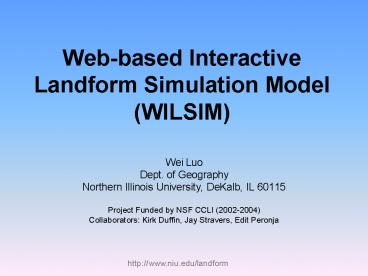Web-based Interactive Landform Simulation Model (WILSIM) - PowerPoint PPT Presentation
1 / 27
Title:
Web-based Interactive Landform Simulation Model (WILSIM)
Description:
be accessible anywhere anytime, no installation. http://www.niu.edu/landform ... Platform independent (write once, run anywhere) 2D. Choose Java Applet ... – PowerPoint PPT presentation
Number of Views:163
Avg rating:3.0/5.0
Title: Web-based Interactive Landform Simulation Model (WILSIM)
1
Web-based Interactive Landform Simulation Model
(WILSIM)
- Wei Luo
- Dept. of Geography
- Northern Illinois University, DeKalb, IL 60115
- Project Funded by NSF CCLI (2002-2004)
- Collaborators Kirk Duffin, Jay Stravers, Edit
Peronja
2
Outline
- My background
- Purposes of WILSIM
- WILSIM Model (how it works, linear, nonlinear
versions) - Graphical User Interface
- Example results from different scenarios
- Summary
3
My Background
- Current position
- Associate Professor, Dept. of Geography, NIU
- Research Interests
- Geomorphology and Hydrology
- Martian drainage patterns and paleoclimate
implications - Quantitative analysis of DEM data
- Computer simulation of landform evolution
- Basin morphometry and hydrologic response
- GIS applications
- Web-based technology in enhancing teaching and
learning
4
Introduction
- Landform evolution an important aspect of earth
sciences - involves multiple processes over long geologic
time - Ideal topic to train students about systems
approach - Long-term landform evolution cannot be observed
directly - Computer simulation is an ideal tool to teach
- Usually requires special programs or
visualization software that is not easily
accessible to students
5
Purposes of WILSIM
- To provide an easily accessible tool that can
improve learning through interactive exploring - It should
- simulate first order features resulted from
multiple processes - be interactive, dynamic, visual, and fun
- allow for exploration (what-if scenarios)
- be accessible anywhere anytime, no installation
6
Visualization and Animation
- Need to see the landform change over time in 3D
- Options
- The Virtual Reality Markup Language (VRML)
- Dynamic changes of complex scene geometry not
allowed - Java 3D
- Not available for all computing environments
- Java Applet
- Platform independent (write once, run anywhere)
- 2D
- Choose Java Applet
- custom renderer to show 3D animation
7
WILSIM how it works (cellular automata
algorithm)
- Drop storm event (precipiton) randomly onto a
cell of a topographic grid (1) - Cause local diffusion at its 4 direct neighboring
cells (3, 5, 7, and 9) - Erode material from current cell (1) and move to
lowest neighbor (2). - continue to move to the lowest neighboring cell
and erode along the way until it reaches the edge
of the grid, lands in a pit or its carrying
capacity is exceeded - Start a new precipiton and iterate hundreds of
thousands of times
erosion
diffusion
(Figure adapted after Chase, 1992)
8
WILSIM linear version
- Amount of erosion is proportional to local slope
and erodibility - (1)
- where is the maximum possible erosion
- c is proportional constant
- e is the erodibility of material in current
cell - s is local slope of current cell
- Precipitons are independent of each other
9
WILSIM non-linear version
- Amount of erosion
- (2)
- where is the maximum possible erosion
- c is proportional constant
- e is the erodibility of material in current
cell - a is contributing area to current cell
- s is local slope of current cell
- m and n are exponent coefficients.
- When mn1, Eq. (2) becomes Eq. (1)
10
WILSIM non-linear version (contd)
- Contributing Area a
- Run D8 algorithm before each iteration
- Precipitons are now inter-related
- Previous erosion leads to larger a
- Precipitons tend to follow previous path (ants)
11
Graphical User Interface
12
Graphical User Interface (contd)
13
Graphical User Interface (contd)
14
Graphical User Interface (contd)
15
Graphical User Interface (contd)
16
Graphical User Interface (contd)
(Hypsometric curve of the whole simulation grid)
17
Graphical User Interface (contd)
18
Constant Erodibility, Constant Climate No
Tectonic UpliftLinear Model
19
Constant Erodibility, Constant Climate No
Tectonic UpliftNon-Linear Model
20
Constant Erodibility, Constant Climate Tectonic
UpliftLinear Model
21
Constant Erodibility, Constant Climate Tectonic
UpliftNon-Linear Model
22
Different Erodibility, Constant Climate
Tectonic UpliftLinear Model
23
Different Erodibility, Constant Climate
Tectonic UpliftNon-Linear Model
24
Constant Erodibility, Increasingly Drier Climate
Tectonic UpliftLinear Model
25
Constant Erodibility, Increasingly Drier Climate
Tectonic UpliftNon-Linear Model
26
Summary
- Comparing with the linear version, the nonlinear
version of WILSIM more faithfully simulates
natural erosion processes - Results look more realistic
- More integrated drainage networks and extending
further upstream - More incision in valleys in the uplifting block
and more escarpment retreat - Rougher surface (higher fractal dimension)
- WILSIM can help enhance the learning of landform
evolution processes and concepts through its
visualization and exploration capability - Accessible anywhere, easy to use, no installation
- Limitations
- Simplified model of real world
- Scale (spatial, temporal) needs to be calibrated
27
- Luo, W. and M. Konen, 2007, New results from
from Using a Web-based Interactive Landform
Simulation Model (WILSIM) in a General Education
Physical Geography Course, Journal of Geoscience
Education, v. 55, n5, n.5, p. 423-425 - Luo, W., Peronja, E., Duffin, K., Stravers, A.
J., 2006, Incorporating Nonlinear Rules in a
Web-based Interactive Landform Simulation Model
(WILSIM), Computers and Geosciences, v. 32, n. 9,
p. 1512-1518 (doi 10.1016/j.cageo.2005.12.012). - Luo, W., Stravers, J., and K. Duffin, 2005,
Lessons Learned from Using a Web-based
Interactive Landform Simulation Model (WILSIM) in
a General Education Physical Geography Course,
Journal of Geoscience Education, v. 53, n. 5, p.
489-493 - Luo, W., K.L. Duffin, E. Peronja, J.A. Stravers,
and G.M. Henry, 2004, A Web-based Interactive
Landform Simulation Model (WILSIM), Computers
and Geosciences. v. 30, n. 3, p. 215-220

